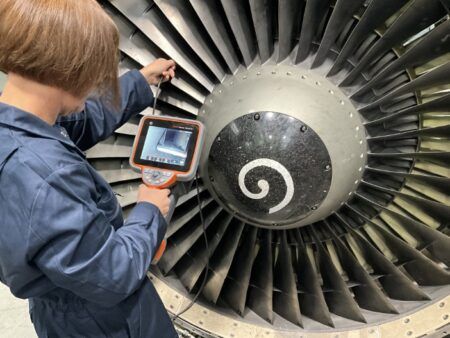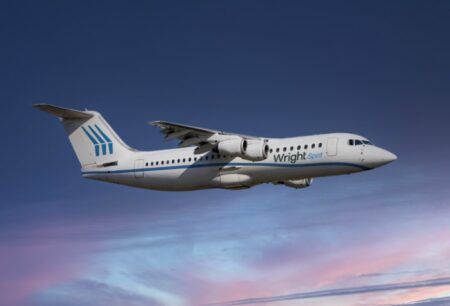NASA proclaimed the birth of a new era of aviation earlier this year when it announced it was to begin testing a distributed electric propulsion technology on the experimental aircraft designated X-57.Speaking to Aerospace Testing International in October, Sean Clarke, NASA’s principle investigator on the X-57, said he views the project as the first step in a program that seeks to demonstrate many new opportunities for aircraft design: opportunities that would allow the industry not only to drastically reduce fuel consumption, engine emissions and noise, but also make aviation more accessible to the public.
The X-57 is nicknamed the ‘Maxwell’ after the 19th century Scottish physicist James Clerk Maxwell in recognition of his work on electromagnetism. The demonstrator will be created by modifying a Tecnam P2006T twin-engine, light aircraft; the conventional wing and two piston engines will be replaced by a long, skinny wing embedded with 14 electric motors all turning propellers. There will be 12 motors on the leading edge for take-off and landing, and one larger motor on each wing tip for use while at cruise altitude.
Clarke hopes the aircraft will highlight what he describes as some of the “radical” improvements to aerodynamic efficiency that electric propulsion makes possible.
“We are designing this aircraft to take advantage of installing the propulsion system in locations on the vehicle that were not practical with turbine and piston engines,” he says. “Electric motors are lighter and are very efficient across a wide range of power levels, and they will continue to become more and more reliable as the technology matures further.”
The Maxwell is part of NASA’s New Aviation Horizons initiative, which will include the development of as many as five larger transport-scale X-planes, all intended to introduce advanced technologies into the market.
NASA expects the X-57 itself will prove that by distributing the electric power across a number of motors, carefully integrated with the wing, it is possible to achieve a fivefold reduction in the energy required by an airplane of its size to cruise at 175mph. Researchers believe this could translate into a 40% reduction in overall operating costs for small aircraft. Typically, to get the best fuel efficiency, an airplane has to fly slower than it is able. Electric propulsion essentially eliminates the penalty for cruising at higher speeds.
In addition, the X-57 will be powered by batteries, eliminating carbon emissions in flight.
There have been many attempts at electrically powered airplanes in recent decades, including manned and unmanned aircraft. The drone industry has taken advantage of improvements in battery technology and energy density; progress has also been made in the development of solar-powered and fuel cell powered aircraft such as the Helios Prototype and the Solar Impulse 2, which completed the first around-the-world flight earlier this year.
However, Clarke says advances in electric motors and the ability to integrate airframe and propulsion design are now at a stage where it is possible to build a demonstrator with a view to commercialization. “We have been studying the potential of tightly coupled propulsion airframe integration (PAI) for many years, and are excited by the state of the art of electric motors and the PAI design tools that are finally letting us build a demonstrator with these key technologies.”
Multiple research
The X-57 Maxwell belongs to the SCEPTOR project (Scalable Convergent Electric Propulsion Technology and Operations Research), which is a collaboration across several NASA centers, and is one of several projects seeking to advance electric propulsion technologies.Another is the Hybrid Electric Integrated Systems Testbed (HEIST) at Armstrong Flight Research Center. HEIST will allow researchers to study the interaction between multiple energy sources, such as batteries, turbines and fuel cells; it will also aim to develop novel control laws that will take advantage of the unique capability of these distributed electric propulsion systems to reduce the reliance of drag-based control surfaces such as ailerons and rudders.
There is also the NASA Electric Aircraft Testbed (NEAT) at the Glenn Research Center, which is working on advanced electric propulsion component and powertrain models. Clarke said the aim was to optimize the next generation of electric propulsion components such as motors, generators and power inverters.
Meanwhile, the development of the X-57 is split into several configuration stages referred to as modifications. Mod 1 included testing of an unmodified Tecnam P2006T aircraft to collect stock handling and performance data. In Mod 2, the team will flight test an electrified version of the P2006T with batteries instead of fuel tanks, and high-performance electric motors instead of engines.”This will allow us to evaluate the operational and safety capability of the electric powertrain in a flight environment,” explains Clarke. In Mod 3, the team will replace the standard wing with one designed “for optimized propulsion airframe integration”.
Clarke says, “This means the electric motors will be located at the wingtips so that they reduce the vortex energy for lower drag, and the wing will have a higher aspect ratio for optimized cruise performance. This will result in compromised low-speed stall characteristics in this phase, though.”
In Mod 4, which is not yet approved, Clarke says they hope to demonstrate how leading-edge propellers driven by distributed electric motors across the wing would recover the low-speed stall capability enabling operation throughout the original P2006T envelope.
“We completed the Mod 1 flight tests in 2015, and plan to conduct Mod 2, 3, and, if approved, 4 flight tests in 2018, 2019 and 2020 respectively.”
Coupled conundrum
The X-57 design incorporates a “highly coupled” motor, propeller and wing interaction, which presents both a challenge and an opportunity, says Clarke.
“Our redesigned wing relies on the propeller locations to achieve the targeted performance, but also presents structural integration challenges when incorporating so many distributed masses. It’s also a very small volume as a result of the higher aspect ratio, so we are challenged to incorporate our experimental power distribution system alongside our command databus, our research instrumentation system, and our mechanical flight control system.”
The opportunity, says Clarke, is to mature the relevant technologies to a level at which the aerospace industry can then adopt the design techniques. “We plan to demonstrate a five-times improvement in efficiency at high-speed cruise flight, which is a huge leap forward in aircraft performance that should scale to even larger vehicles.”
The approach to the first flight tests will be taken in steady, incremental steps. Clarke says the new electrical components, such as the motor testing, will mirror many of the conventional engine development stages.
“We are completing ground testing on our high-precision motor test stand (Airvolt) in order to evaluate the motor design, reliability and operation in a similar test program to a new engine checkout. We will conduct increasingly integrated subsystem and system tests leading up to a Combined Systems Test, taxi tests, and eventually flight.”
The build-up to the final Mod 4 configuration is designed to carefully introduce new technologies in the safest configuration possible.
“In Mod 2, we will demonstrate airworthiness of our experimental electric powertrain all the way from the batteries to the motors and all the power components in-between,” he says. “This will be done in a controlled vehicle configuration such that a failure anywhere in the system will be easily handled by our test pilot. When we graduate this power system design to Mod 3, we will have a more challenging failure mode that we will be prepared for: the loss of propulsion at one wingtip. We will mitigate this by limiting motor power at the wingtips during take-off and landing, and using the long main runway available to us at Edwards Air Force Base – 12,000ft paved with an additional 5,000ft of groomed surface on the dry lakebed. This will ensure that the pilot always has sufficient control authority by getting airflow over the rudder and ailerons with a minimum of power.
“Once we are airborne, we will methodically expand the flight envelope to reach the high-speed cruise design point and demonstrate the drastically reduced energy required by our demonstrator as compared with the original Mod 1 configuration.”
The team also conducted ground-based tests of a full-scale wing with distributed electric propulsion, similar to the design used on the X-57. As part of the Leading Edge Asynchronous Propeller Technology (LEAPTech) project, the test fixture was mounted on a truck and driven at different speeds and angles.”We completed a series of tests at up to 80mph and various wing elevation angles, power settings on the motors (up to 300 horsepower total), and flap configurations,” says Clarke. In addition, the team also used several CFD models of the aircraft to quickly optimize the integration of the propulsion systems and the airframe.
Distributed electronic propulsion will not only help to reduce fuel consumption and emissions, it could also offer some progress on solving the vexed issue of aircraft noise. On take-off and landing, the technology could make it possible to improve performance within the noise limitations of a typical general aviation airfield, although acoustic testing hasn’t been scheduled yet.
“We haven’t committed to acoustic testing with the SCEPTOR project, but we will be evaluating what research opportunities this vehicle could provide, given our unique configuration,” says Clarke. “NASA is studying these effects with acoustic models and the X-57 configuration could be an ideal test platform for this.”
New chapter
NASA believes electric propulsion offers many new opportunities for aircraft design, of which the X-57 Maxwell will highlight just a few. This is the beginning of a new chapter, claims Clarke, which will make this type of aircraft, and aviation in general, more available to the public, particularly with the continued improvement in battery technology.
“Battery technology has been improving at an exponential pace for many years, and if it continues at this rate, all-electric aircraft will have more and more market niches available to them,” he says. “Many of the X-57 technologies are equally relevant in a hybrid configuration, which will overcome the reduced energy density of batteries in the near term. These technologies, along with improved autonomy and next-generation air traffic control, are poised to make aviation more accessible to the public than ever before.”
George Coupe is an engineering and technology writer based in the UK.
This article was also published in the December 2016 issue of Aerospace Testing International magazine.




